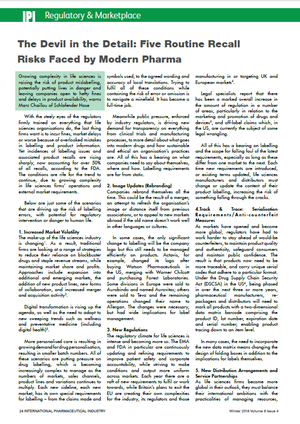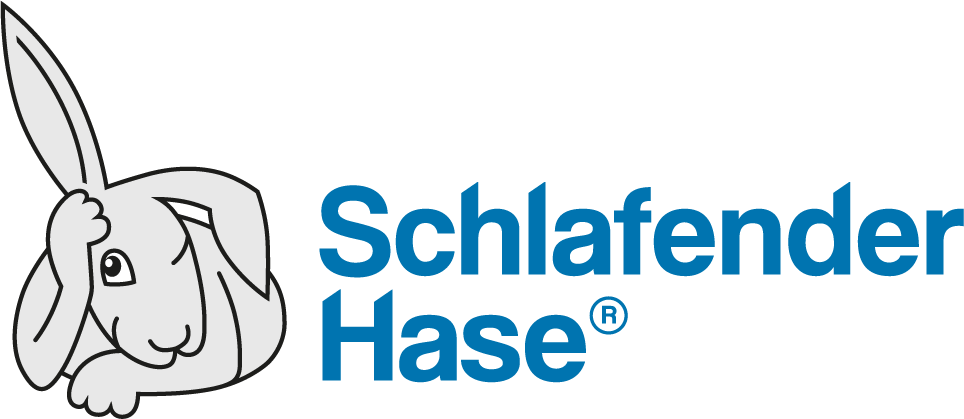
From International Pharmaceutical Industry January 2017
With the steely eyes of the regulators firmly trained on everything that life sciences organisations do, the last thing firms want is to incur fines, market delays or worse because of overlooked mistakes in labelling and product information. Yet incidences of labelling issues and associated product recalls are rising sharply, now accounting for over 50% of all recalls according to the FDA. The conditions are rife for the trend to continue, due to growing complexity in life sciences firms’ operations and external market requirements.
Below are just some of the scenarios that are driving up the risk of labelling errors, with potential for regulatory intervention or danger to human life.
1. Increased market volatility
The make-up of the life sciences industry is changing[1]. As a result, traditional firms are looking at a range of strategies to reduce their reliance on blockbuster drugs and staple revenue streams, while maintaining market share and profits. Approaches include expansion into additional and emerging markets, the addition of new product lines, new forms of collaboration, and increased merger and acquisition activity[2].
Digital transformation is rising up the agenda, as well as the need to adapt to new sweeping trends such as wellness and preventative medicine (including digital health)[3].
More personalised care is resulting in growing demand for drug personalisation, resulting in smaller batch numbers. All of these scenarios are putting pressure on drug labelling, which is becoming increasingly complex to manage as the numbers of markets, sales channels, product lines and variations continues to multiply. Each new side line, each new market, has its own special requirements for labelling – from the claims made and symbols used, to the agreed wording and accuracy of local translations. Trying to fulfil all of these conditions while containing the risk of error or omission is to navigate a minefield. It has become a full-time job.
Meanwhile public pressure, enforced by industry regulators, is driving new demand for transparency on everything from clinical trials and manufacturing processes, to more detail about what goes into modern drugs and how sustainable and ethical an organisation’s practices are.
All of this has a bearing on what companies need to say about themselves, where and how. Labelling requirements are far from static.
2. Image updates (rebranding)
Companies rebrand themselves all the time. This could be the result of a merger, an attempt to refresh the organisation’s image or distance itself from previous associations, or to appeal to new markets abroad if the old name doesn’t work well in other languages or cultures.
In some cases, the only significant change to labelling will be the company logo but this still needs to be managed efficiently on products. Actavis, for example, changed its logo after buying Watson Pharmaceuticals in the US, merging with Warner Chilcott and purchasing Forest Laboratories. Some divisions in Europe were sold to Aurobindo and named Aurovitas; others were sold to Teva and the remaining operations changed their name to Allergan. The changes were necessary, but had wide implications for label management.
3. New regulations
The regulatory climate for life sciences is intense and becoming more so. The EMA and FDA in particular are continuously updating and refining requirements to improve patient safety and corporate accountability, while striving to make conditions and output more uniform across markets. Each year there are a raft of new requirements to fulfil or work towards, while Britain’s plans to exit the EU are creating their own complexities for the industry, its regulators and those manufacturing in or targeting UK and European markets[4].
Legal specialists report that there has been a marked overall increase in the amount of regulation in a number of areas, particularly in relation to the marketing and promotion of drugs and devices[5], and off-label claims which, in the US, are currently the subject of some legal wrangling.
All of this has a bearing on labelling and the scope for falling foul of the latest requirements, especially as long as these differ from one market to the next. Each time new requirements are introduced, or existing terms updated, life sciences manufacturers and distributors must change or update the content of their product labelling, increasing the risk of something falling through the cracks.
4. Track & trace: serialisation requirements/anti-counterfeit measures
As markets have opened and become more global, regulators have had to work harder to stay ahead of would-be counterfeiters, to maintain product quality and authenticity, safeguard consumers and maintain public confidence. The result is that products now need to be more traceable, and carry unique serial codes that adhere to a particular format. Under the Drug Supply Chain Security Act (DSCSA) in the US[6], being phased in over the next three or more years, pharmaceutical manufacturers, re-packagers and distributors will need to mark all products with a two-dimensional data matrix barcode comprising the product ID, lot number, expiration date and serial number, enabling product tracing down to an item level.
In many cases, the need to incorporate the new data matrix means changing the design of folding boxes in addition to the implications for labels themselves.
5. New distribution arrangements & service partnerships
As life sciences firms become more global in their outlook, they must balance their international ambitions with the practicalities of managing resources, skills and knowledge across new markets.
With uncertain new geographical markets, a company may hold off making a local investment in operations, preferring instead to use a local partner. As well as increasing the organisational/supply chain complexity, this can also dilute a firm’s control over process continuity, and imposing and maintaining standards. Similarly, outsourcing of routine processes (some pharma and medical device companies outsource labelling and proofreading activities to third parties to save money) can reduce companies’ ability to ensure consistent, compliant labelling, despite the bias towards local market knowledge.
Introducing additional layers and additional parties can also make it less clear who is ultimately responsible for quality control and regulatory compliance, leaving companies open to risk. Attention to detail is likely to vary according to who is in charge, who they report to, and what their immediate key performance indicators are. This is despite the fact that the risk of exposure to penalty, market delay and reputational damage – if products are mislabelled for a target market – is of central, corporate concern. If an organisation’s name is on the product, the consequences of an error will always come back to the HQ of the brand owner, no matter who is actually at fault. Ultimately, the impact will be on the main company’s brand, reputation and stock price.
Standard operating procedures must be extended right across the international organisation, while spanning any commercial or supporting service partners, if life sciences firms are to protect themselves fully against the dangers of product mislabelling.
Why take the risk? Use TVT
The more complex life sciences operations become, the greater the temptation to allocate more resources to checks and cross-checks. Yet, no matter how many people are involved in the proofreading process, humans will never pick up 100 percent of errors. And often it is the smallest omission or typo that proves to be a company’s undoing.
People make mistakes. Even with two sets of eyes on a document, proof-readers can develop blind spots – either because they’ve looked at the same content for too long, or because the task is so repetitive and unstimulating that the brain has become distracted[7]. Yet even the smallest editing or artwork oversight can have serious consequences: for example the difference between “store this product at 2-8°C” and “store this product at 28°C”; “take 1-2 a day” and “take 12 a day”; or “do not chew and swallow” and “do not not chew and swallow”. So these are risks companies can’t afford to take.
In a brutally competitive market, time is money. If you set two copies of the novel Huckleberry Finn side by side, each 500,000 words long but with several subtle differences, it would typically take a reliable text verification tool just three minutes to pick up all of the anomalies. By contrast a human proof-reader would need about a week to complete the same task, with no guarantee they would identify all of the ‘errors’ the first time.
Even if a recall is eventually averted by human intervention, discovering an issue late in the process could knock out production lines. And, for each day that a product is not on the store shelves, sales are lost and competitors have an advantage.
A further benefit to life sciences organisations in streamlining their labelling processes is the potential to redeploy labour. A survey we conducted in 2014 found that companies that have implemented reliable automated proofing typically save an hour per label or, in the case of multiple countries and languages, a day per product; correction cycles are also significantly reduced.
More usually companies with automated proofing save five hours per week on manual document verification. Extrapolating this against the average salary of a specialist Regulatory Affairs employee (estimated at $85,000)[8], this works out at a yearly saving/productivity increase of $13,500 per user. This is at a time when regulatory professionals are in high demand because of all of the other pressures they are currently dealing with.
Life sciences firms have enough on their plates at the moment, without making things unnecessarily difficult for themselves. If the devil is in the details, don’t leave it to chance to identify it.
This article is taken from International Pharmaceutical Industry January 2017
References
[1] New report highlights changing business models in life sciences sector, Oxford Intelligence, May 2014: http://www.oxint.com/pressdetails.cfm?id=109&title=New%20report%20highlights%20changing%20business%20models%20in%20life%20sciences%20sector
[2] Appetite for M&A activity in global life sciences and health care sector set to increase in the next three years, according to Deloitte survey, Deloitte, October 2014: https://www2.deloitte.com/gt/en/pages/about-deloitte/articles/lifesciences-manda-trends-survey.html
[3] Disruptive Technologies and Emerging Trends Drive Life Science Transformation, Frost & Sullivan, June 2016: http://ww2.frost.com/news/press-releases/disruptive-technologies-and-emerging-trends-drive-life-science-transformation/
[4] Brexit and the Pharma & Life Sciences industry – there will be change, PwC, July 2016: http://pwc.blogs.com/health_matters/2016/07/brexit-and-the-pharma-life-sciences-industry-there-will-be-change.html
[5] The life sciences, drugs and healthcare industry in 2016 and beyond: trends and predictions, Practical Law, 2016: http://uk.practicallaw.com/2-628-0625
[6] Drug Supply Chain Security Act (DSCSA) for Pharmaceutical Manufacturers, GS1 US, October 2015: https://www.gs1us.org/DesktopModules/Bring2mind/DMX/Download.aspx?command=core_download&entryid=1298&language=en-US&PortalId=0&TabId=785
[7] What’s Up with That: Why It’s So Hard to Catch Your Own Typos, Wired.com, August 2014: http://www.wired.com/2014/08/wuwt-typos/
[8] RAPS.org: Salary Calculator: http://www.raps.org/jobs-careers/salary-calculator/





